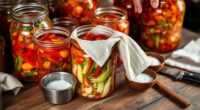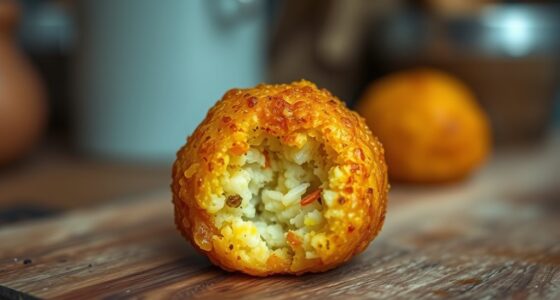Baking from scratch lets you control every step, from selecting high-quality ingredients to mastering fermentation techniques. You can create flavorful sourdough, flaky croissants, and delicate pastries by adjusting hydration, timing, and ingredient quality. Understanding fermentation deepens flavors and improves texture, while sourcing the right ingredients supports natural yeast growth. If you want to discover how ingredient choices and process techniques come together, continue exploring to uncover the full potential of your homemade baked goods.
Key Takeaways
- Mastering fermentation techniques enhances flavor development and texture in sourdough, croissants, and pastries.
- Sourcing high-quality, fresh ingredients supports natural yeast growth and improves baking outcomes.
- Baking from scratch allows full control over ingredients, leading to personalized, flavorful baked goods.
- Understanding ingredient properties, like gluten strength and fat content, optimizes lamination and rise.
- Connecting technique with ingredient choice deepens craftsmanship and elevates traditional baking recipes.

Have you ever wondered how much better homemade baked goods taste when you start from scratch? It’s a feeling that comes from controlling every step, from selecting ingredients to mastering fermentation techniques. When you bake from scratch, you’re not just following a recipe—you’re creating something truly personal and flavorful. One of the most rewarding aspects is understanding fermentation techniques. Whether you’re cultivating a sourdough starter or allowing croissant dough to develop, fermentation transforms simple ingredients into complex, aromatic delights. It’s a slow process, but patience pays off with a richer taste and better texture. You get to observe the natural rise, the bubbles forming in your starter, and notice how flavors deepen over time. This process also helps you better understand ingredient sourcing, as choosing quality flour, water, and other components becomes vital. Sourcing the best ingredients makes a significant difference, especially since fermentation relies heavily on the natural qualities of your ingredients. Fresh, high-quality flour, for instance, provides the perfect environment for wild yeast and bacteria to thrive, leading to a more vibrant sourdough or pastry dough. When you’re intentional about ingredient sourcing, you’re more connected to your baking and can experiment confidently, knowing that your ingredients are supporting your fermentation techniques. Additionally, understanding the importance of natural fermentation can help you appreciate the biological processes that develop flavor and texture in your baked goods.
Baking from scratch means you’re in control from the very beginning. You decide whether to use organic flour or locally milled grains, which can add depth to your baked goods. This level of control guarantees that your final product isn’t just about taste but also about quality and health. For sourdough, starting with good-quality, well-sourced flour makes your fermentation more predictable and robust. It also allows you to fine-tune your techniques, adjusting hydration levels or fermentation times based on your ingredients’ characteristics. Croissants and pastries benefit from ingredient sourcing as well, especially when you select butter with the right fat content or flour with the ideal gluten strength. These choices influence how your dough behaves during lamination and baking, resulting in flaky, tender layers. By paying attention to your ingredients and mastering fermentation techniques, you elevate your baking from simple to extraordinary. It’s about creating a connection to your craft, understanding how each element impacts the final product, and enjoying the process of bringing your baked goods to life from scratch.
Frequently Asked Questions
How Do I Maintain and Store Sourdough Starter Long-Term?
To maintain your sourdough starter long-term, you should store it in a sealed container in the fridge, which slows fermentation. Regularly monitor fermentation by observing bubbles and activity, and feed it with fresh flour and water to keep it healthy. Adjust hydration levels to match your baking needs, and feed it weekly if refrigerated. This way, your starter stays vigorous and ready whenever you want to bake.
What Are Common Mistakes When Shaping Croissants?
When shaping croissants, you might struggle with laminating techniques and shaping consistency. To avoid mistakes, make sure your dough is properly chilled to prevent sticking and tearing. Use firm but gentle pressure when rolling and shaping, maintaining even thickness. Practice your laminating techniques to create layers without overworking the dough, which can cause uneven shapes. Consistent shaping results in beautifully flaky croissants, so take your time and adjust as needed.
How Can I Tell if My Pastry Dough Is Overworked?
You can tell your pastry dough is overworked if it becomes tough, dense, or resistant to rolling out. Overmixing hazards include excessive gluten development, which toughens the dough and hampers flaky layers. To prevent this, stop mixing as soon as ingredients are just combined, and handle the dough gently. This ensures a tender, flaky pastry with the perfect texture.
What Are Alternatives for Traditional Ingredients in Baking?
Did you know that nearly 10% of the population has gluten sensitivities? You can swap traditional ingredients with gluten alternatives like rice or almond flour, which work well for pastries. Vegans can use substitutes such as flaxseed or aquafaba instead of eggs, and coconut oil instead of butter. These options let you enjoy baked goods without sacrificing flavor or texture, making your baking inclusive and creative.
How Do I Troubleshoot Flat or Dense Baked Goods?
To troubleshoot flat or dense baked goods, first check your yeast activation—make sure it’s fresh and properly proofed before mixing. Also, verify your oven calibration; an oven that’s too cool can prevent proper rise. Avoid overmixing, which can deflate dough, and ensure your ingredients are at the right temperature. With these adjustments, you’ll attain lighter, fluffier results in your baking.
Conclusion
So, don’t be discouraged if your first attempt isn’t perfect. Baking from scratch might seem intimidating at first, but the rewards are worth it. With patience and practice, you’ll master sourdough, croissants, and pastries. Remember, even the pros had to start somewhere. Embrace the process, learn from mistakes, and enjoy the delicious results you create. Before long, you’ll be sharing bakery-quality treats right from your own kitchen.









